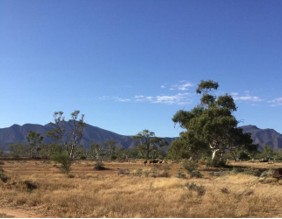Name:
Leonard and Sharon Nutt, Edeowie Station
Location:
Hawker and Quorn
Average Rainfall:
230 mm
Enterprises:
Self-replacing Merino flock, self-replacing cattle, goats (opportunistic) and tourism
Farm Area:
26,850 ha
Leonard and Sharon Nutt are fifth generation farmers who are passionate about the sheep, wool and cattle industries. In an average season Edeowie runs 2,200 merino breeding ewes all mated to merino rams plus 80 breeding cows.
They are the third generation at Edeowie Station.
Their daughter Nikki returned to the farm in 2016 after working in the mining industry.
Although there is always more than enough work for an extra pair of hands they quickly realized that the sheep and cattle enterprises would not be profitable enough. The labour cost per kilogram of wool produced at Edeowie averaged $2.02 over 4 years (2015/16 to 2018/19) compared to the group average of $1.37. The labour cost per head of sheep sold averaged $20.47 over the four years compared to the benchmarking group average of $15.44. In an effort to reduce the labour cost per kilogram of wool and per head of stock sold they have decided to diversify further into tourism. Sharon had been running a small tourism operation, renting out the shearers quarters and a house, but after discussions with their accountant and others in the tourism business they decided to improve their facilities and increase their exposure in 2017 to help diversify the business.
They have established a web site and joined the Station Stays SA group, who work collaboratively to promote stations stays in outback SA at Tourist events and through their web site. Edeowie offer bookings for groups at the shearer’s quarters, a house and also individual camping at three bush camp sites.
There is always a risk in improving and expanding tourism facilities without knowing if this will attract more tourists. However in the first year the income from tourism increased and it has now become an important part of their business with both passing traffic and those booking on-line through the website. This additional income has helped to off-set lower livestock returns in 2019 as the drought continued.
 Native pastures and vegetation on Edeowie Station Photo courtesy www.edeowiestation.com.au
Native pastures and vegetation on Edeowie Station Photo courtesy www.edeowiestation.com.au
Leonard was involved with the BestPrac Group based at Hawker from 2005 until 2010. As a member of this group he had the opportunity to undertake benchmarking to monitor Edeowie’s productivity and profitability and compare this against others in the group. This analysis highlighted some opportunities to improve and refine the business and reinforced the need to change. He has changed ram bloodlines and his selection techniques to improve wool production and quality (wool style and skin type). He is aiming for a soft crimpy white wool with lower dust penetration and high yield.
The cattle herd were also less profitable compared to sheep. Also being a higher risk during periods of drought he decided to reduce cattle numbers. He has been reducing his cattle herd to maintain ewe numbers in the current climate, however the 2018 and 2019 drought has significantly impacted on stock numbers and he sold all of his cattle in mid-2019.
In 2018, Leonard was part of the SheepConnect SA benchmarking group comparing the cost of production for both wool and meat from 2015/16 to 2018/19. Although his cost of production for wool was above the group average, the gross wool proceeds were also above average. The cost per head of sheep sold was below the group average (mainly due to higher lambing percentages) and the gross average sheep sale price was above average, making sheep trading very profitable.
In 2015, Leonard purchased a block south of Quorn and has established a containment feeding area to increase his flexibility to finish lambs to market weights or to maintenance feed ewes, during drought. The neighbours’ share-farm 60 to 80 hectares and grain from this is stored on-farm to feed livestock.
Supplementary feeding ewes to maintain body weight has ensured lambing percentage remains relatively high even in poor seasons, such as 2018 (82%) compared to 67% for the rest of the benchmarking group and 2019 (80%). This has given good cash flow with wether lambs sold as weaners in the Jamestown market and ewe lambs kept and fed in the containment area.
There are numerous creeks and waterways that run through the property and Lenard has been undertaking earth works to slow and spread the water to increase pasture production.
Prepared by Michael Wurst, Primary Industries and Regions SA: Rural Solutions SA (2018).
Print Case Study